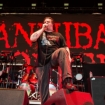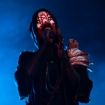From its origins in England, Sweden, and Switzerland to its murderous Norwegian prime and its U.S. resurgence, black-metal has proven harder to extinguish than a fire consuming a church. And while sensational violence and a flirtation with the occult have often threatened to eclipse the genre's artistic merits, it is ultimately the music that has given this dark practice its longevity. Here, Revolver picks 25 albums that define the malefic movement.
Venom - Black Metal
(Neat, 1982)
Not only did this faux-Satanic British power-trio's second album coin the name of a new genre; it also inspired an ultra-violent, nihilistic ideology that inspired the band's Norwegian successors to burn churches and commit murder. The irony, of course, is that Venom were totally kidding.
Bathory - Bathory
(Black Mark, 1984)
This cult Swedish studio band took the lo-fi shittiness of Venom and added icy Norse paganism to the garbled mix. Written and coproduced by vocalist-guitarist Quorthon (who died in 2004), Bathory's homonymous debut also features drummer Jonas Åkerlund, who went on to direct videos for both Madonna and U2 (plus the 2002 crystal meth flick Spun), not to mention the forthcoming controversial Lords of Chaos movie.
Hellhammer - Apocalyptic Raids
(Noise, 1984)
Before vocalist-guitarist Tom G. Warrior formed Celtic Frost with bassist Martin Ain, he was the leader of another Swiss metal trio called Hellhammer. Though the band existed for less than two years, the harsh cacophony of the Apocalyptic Raids demo perfectly expressed black metal's caustic furor.
Darkthrone - A Blaze in the Northern Sky
(Peaceville, 1991)
This Norwegian duo's second album marks drummer-lyricist Fenriz and vocalist-guitarist Nocturno Culto's defection from the traditional death-metal territory of Soulside Journey to the chilling realm of "unholy black metal."
Burzum - Burzum
(Misanthropy, 1992)
The debut by Burzum, the one-man studio project of J.R.R. Tolkien aficionado Varg Vikernes (a.k.a. Count Grishnackh), was originally released on Mayhem guitarist Euronymous' Deathlike Silence Productions. Remarkable for its militaristic severity and creepy synth ambience, Burzum remains one of black metal's earliest masterpieces.
Mayhem - De Mysteriis Dom Sathanas
(Century Black, 1993)
Also originally released on Deathlike Silence, De Mysteriis was Mayhem's scorching full-length follow-up to the seminal Deathcrush mini-LP. The album features longtime drummer Hellhammer, current vocalist Attila Csihar (ex-Tormentor, ex-Aborym), and Burzum's Varg Vikernes (on session bass), who would stab guitarist Euronymous to death shortly after the album's release.
Cradle of Filth - The Principle of Evil Made Flesh
(Cacophonous, 1994)
Back when vocalist Dani Filth was still known as Daniel Davey, British goth ghouls Cradle of Filth unveiled their full-length debut — complete with elaborate keyboard intros, female backing vocals, and naked vampire chicks. Taking said formula to its baroque breaking point over following releases, CoF rose to be possibly the most well-known band in black metal (if you considered them "black metal" at all), not to mention a onetime personal favorite of Bam Margera.
Emperor - In the Nightside Eclipse
(Candlelight, 1995)
Emperor's full-length debut — and final recording with drummer/convicted murderer Bård "Faust" Eithun, In the Nightside Eclipse marked the beginning of symphonic black metal, a style later spit-polished and propelled into the mainstream by Cradle of Filth and Dimmu Borgir.
Dissection - Storm of the Light's Bane
(Nuclear Blast, 1995)
Led by guitarist-vocalist Jon Nödtveidt, Gothenburg's Dissection blurred the line between black metal and the melodic death metal their Swedish city made famous. The band's second album was their last (and finest) riff blizzard before Nödtveidt was imprisoned for murder.
Dimmu Borgir - Stormblåst
(Nuclear Blast, 1996)
Long before they dragged their chain-mail-encased tits onto Ozzfest's main stage, Dimmu Borgir announced made their symphonic bid to dominate Norwegian underground with Stormblåst. The native-tongued LP was rerecorded in 2005, only increasing its original frostbitten grimness.
Marduk - Heaven Shall Burn ... When We Are Gathered
(Osmose, 1996)
Although they have suffered chronic touring setbacks due to vocalist-guitarist Morgan Håkansson's felonious history (which allegedly includes assaulting a police officer and grave robbery), black-metal berserkers Marduk know how to throw down in the studio. On Heaven Shall Burn, the Swedes unleash a blast of unapologetic blasphemy captured devilishly by producer (and Hypocrisy main man) Peter Tägtgren.
Ulver - Nattens Madrigal
(Century Media, 1997)
Although the band would take a severe turn into proggy histrionics (see 2005's Blood Inside), Ulver's third full-length — a savagely shrill concept album about werewolves (subtitle: Eight Hymns to the Wolf in Man) that was supposedly recorded outdoors in an ancient Norwegian forest — could turn any mere man into a murderous beast
Gorgoroth - Destroyer
(Nuclear Blast, 1998)
Four years in the making, Gorgoroth's fourth effort borrows the title of Kiss' 1976 album, boasts four different vocalists (sensing a pattern here?) — including their particularly notorious former frontman, Gaahl — and features guest drumming from Satyricon's Frost. Unrelenting from front to back, Destroyer closes with a cover of Darkthrone's "Slottet I Det Fjerne."
Satyricon - Rebel Extravaganza
(Nuclear Blast, 1999)
Widely discounted by apparently deaf journalists as some sort of goth/industrial crossover release, Rebel Extravaganza sounds more like a black-metal version of Voivod than anything else. Satyricon's fourth album is not just another underappreciated sonic blitzkrieg, it's actually Phil Anselmo-approved: Pantera tapped the band to open their 2000 European tour.
Weakling - Dead as Dreams
(tUMULt, 2000)
In 2000, Weakling created a world all their own with Dead as Dreams, following in the footsteps of early Emperor, Ulver and Burzum to create moving, beautiful black metal that crossed over into ambient and post-rock. Hands down one of the most important USBM (U.S. black metal) LPs of all time, highly influential to the likes of Wolves in the Throne Room and Deafheaven, the group's lone full-length is also a crucial release for black metal at large.
Sigh - Imaginary Sonicscape
(Century Media, 2001)
On their fifth album, this Japanese trio (now a quartet) shed their corpse paint but not their insatiable appetite for increasingly progressive black-metal. Imaginary Sonicscape revels in the pleasures of magic mushrooms, evil moog keyboards, and dizzying arrangements; plus, the lyrics to "Nietzschean Conspiracy" were written by then-imprisoned Emperor drummer Faust.
Immortal - Sons of Northern Darkness
(Nuclear Blast, 2002)
Since reissued with a bonus live DVD, the seventh album from Norwegian power triad Immortal is practically unstoppable. Produced by Peter Tägtgren, Sons of Northern Darkness combines fierce riffery with a Maiden-esque sense of epic dynamism. (Fun fact: One of the band's promotional photos for this release mistakenly caught guitarist-vocalist Abbath with his fly down.)
Leviathan - Tentacles of Whorror
(Moribund, 2004)
The one-man plague of professional tattoo artist Jef Whitehead (a.k.a. Wrest), Leviathan are the vanguard of the American isolationist black-metal phenomenon. Whitehead's second full-length under the Leviathan moniker, Tentacles is a vicious display of lo-fi pyrokinesis that takes its cues from the Burzum back catalog.
Xasthur - To Violate the Oblivious
(Moribund, 2004)
Another one-man outfit, L.A.'s Xasthur is the brainchild of Scott Conner, a.k.a. Malefic, also known for his live guest "vo-kills" with sub-harmonic drone overlords Sunn O))). The bleak psychedelic hellscapes that bleed black through each of his many LPs, EPs, and splits are at their most unsettling on this, Xasthur's fourth full-length.
Deathspell Omega - Kénôse
(Ajna Offensive, 2005)
Little is known about this reclusive French posse; the band refuses almost all interview requests. But Kénôse is one of the most powerful, ideologically intriguing black-metal releases in the history of forever. Ominous and brooding, the hypnotic fury of the album's three epic tracks is matched only by its enigmatic artwork.
Enslaved - Isa
(Candlelight, 2005)
Along with Darkthrone, the reunited Emperor, Varg Vikernes and the surviving members of Mayhem, Enslaved are the last of Norway's living black-metal O.G.s. Their Grammy-winning eighth album is a rousing Viking feast that makes you wanna burn and pillage all the way to Valhalla — and proof that these originators are still well ahead of most of the pack.
Lurker of Chalice - Lurker of Chalice (2005)
(Total Holocaust, 2005)
Much like Varg Vikernes did through Burzum's experimentation with keyboards, Leviathan's Jef Whitehead (re)established black metal as not just a sound, but a feeling and approach, with his project Lurker of Chalice and its sole, self-titled offering. Wildly inventive, employing everything from electronic samples to wind chimes and chorus vocals, the album proves that all the chilling darkness of the subgenre can be conjured without a lo-fi tremolo riff.
Watain - Sworn to the Dark
(Season of Mist, 2007)
Despite their infamous penchant for literal mid-set bloodbaths, the Swedish pyromaniacs Watain have always been a band defined by sharp songcraft, not just provocative showmanship. Case in point: Sworn to the Dark, which saw the Satanic firebrands culling from thrash, hard rock, prog and dark ambient to deliver one of the most stylistically diverse black-metal albums of the 2000s.
Behemoth - The Satanist
(Metal Blade, 2013)
While their music arguably leans more death metal, these Polish blasphemers' explicitly Satanic philosophical stance and corpse-paint-and-hellfire onstage presentation clearly place them within the black-metal movement. Behemoth's comeback album after frontman Nergal's near-fatal battle with Leukemia, The Satanist stands as a majestic and vital (re)statement of intent.
Deafheaven - Sunbather
(Deathwish, 2013)
Deafheaven's sophomore LP Sunbather represented a true paradigm shift in black metal both in its aesthetics and attitudes, from its pink album cover to its sunny riffage. Indeed, the first notes of "Dream House" evoke something not often heard in the genre: a feeling of optimism. Sunbather leaned on the creativity of bands past, but took it next level, embracing elements of shoegaze, post-rock and screamo in the way that hadn't been done before. But its greatest innovation may be the way the album rides on the belief that black metal doesn't have to be antisocial in spirit; indeed, it can come with open arms.











